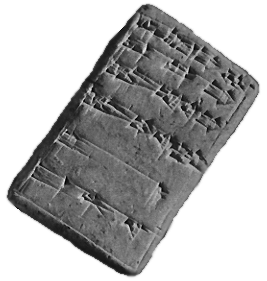

This years' Haskell lecturer, Peter Machinist of Harvard University, provided more than a lecture series while he visited Oberlin last month. He also translated the inscription on a cuneiform in special collections and told Dina Schoonmaker, head of special collections, some details of how Oberlin came to acquire it.
 This cuneiform, shown lifesize, is easily the oldest objet in special collections, says head of special collections Dina Schoonmaker.Photo Credit: Rick Sherlock
This cuneiform, shown lifesize, is easily the oldest objet in special collections, says head of special collections Dina Schoonmaker.Photo Credit: Rick Sherlock
Machinist visited special collections at the request of a student who wanted him to see Oberlin's two Torah scrolls. While there he looked at the cuneiform, a small clay tablet incised with a stylus. Roughly 2 x 3 inches, the cuneiform was made during the old Babylonian period of Mesopotamian history about 4,000 years ago. The king named in it, Sinkashid of Uruk, lived from 1865 to 1833 BC.
The literal translation that Machinist provided is: "Sinkashid, mighty man, king of Uruk, king of the Amnanum [a tribal group], provider for Eanna [the temple], the palace of his kingship he built."
Before Machinist's visit, all Schoonmaker knew about the cuneiform was that it was given to Oberlin College in the 1930s by someone named Edgar J. Banks. "We had no idea why it was here," she says. Machinist told her that Banks was in the British Expeditionary Force in southern Iraq--then Mesopotamia--following World War I. He collected cuneiform tablets, excavating some from sites himself and buying others. Later he gave away or sold some of the collection, mainly to small institutions, "sprinkling them throughout the world," Schoonmaker says. He gave "quite a few" to Dyke College in Cleveland, perhaps through the mediation of John D. Rockefeller, Jr.
